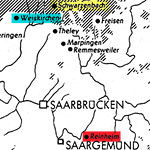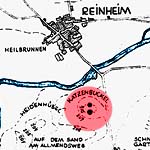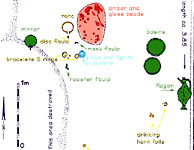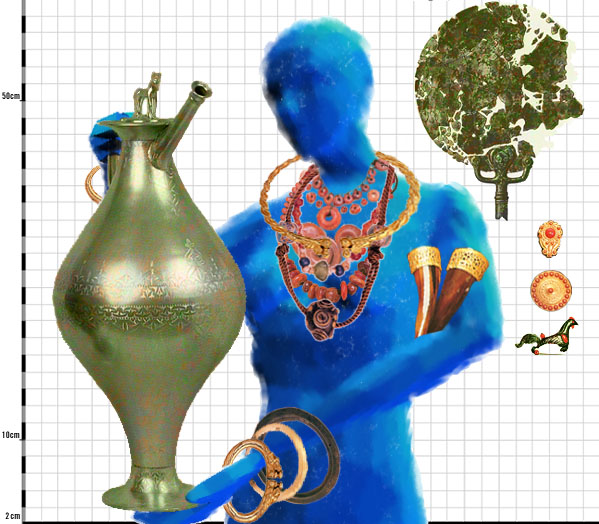
Reinheim and other sites between the Rhine and the Saar
 |
|
Reinheim and other sites between the Rhine and the Saar |
Reinheim is located on a low-lying plain by the river Blies a few
kilometers north-east of the modern city of Saargemünd, where
the Blies flows into the Saar, a major north-south-flowing river. The
border between Germany and France lies just to the south of Reinheim.
The burial discussed here was one of several tumuli located south of
the Blies, on the other side of the river from the modern village of
Reinheim. Although finds from the Bronze Age on testify to the
continual occupation of the area, the Iron Age settlement site has
not been localized. Agriculture and continuous use of the land has
changed the topography since antiquity; the
 "Katzenbuckel" tumulus group was
entirely leveled and the princely burial was only found during
quarrying activities. Part of the tomb's western section was
destroyed before it was recognized as such; professional excavation
was undertaken in 1954. The preserved finds and reconstructions are
now on display in the Museum für Vor- und Frühgeschichte in
Saarbrücken. The burial was published in 1965 by J.
Keller; particularly the gold jewelry has been
much studied and discussed since, and was a highlight of the exhibit
"Hundert Meisterwerke Keltischer Kunst" in
1992-3.
"Katzenbuckel" tumulus group was
entirely leveled and the princely burial was only found during
quarrying activities. Part of the tomb's western section was
destroyed before it was recognized as such; professional excavation
was undertaken in 1954. The preserved finds and reconstructions are
now on display in the Museum für Vor- und Frühgeschichte in
Saarbrücken. The burial was published in 1965 by J.
Keller; particularly the gold jewelry has been
much studied and discussed since, and was a highlight of the exhibit
"Hundert Meisterwerke Keltischer Kunst" in
1992-3.
The Reinheim burial, as preserved, consists of indigenous objects only. Imported coral and amber are present in large quantities, but they are incorporated into jewelry of Celtic type. Reinheim was selected for inclusion in this study because of its excellent publication record, and because the finds exemplify early La Tène style in the central Celtic area. The tomb assemblage was returned to Saarbrücken after conservation and restoration in Mainz, and is displayed in a manner that maximizes the viewer's understanding of the grave context itself -- the find site has been reconstructed with the objects depicted in situ. At the same time, the objects themselves are made accessible to art-historical analysis. Reinheim thus represents not only twentieth-century excavation and conservation techniques, but also optimal museal presentation of a Celtic burial to a wide audience. Reinheim joins with Vix and Waldalgesheim in forming our view of opulent women's burials in the Early La Tène period.
The burial of the Reinheim "Princess" is one of a cluster of
wood-clad chamber tombs under tumuli. Careful excavation of
the "Katzenbuckel" revealed that the princess's tumulus was
originally ca. 23 m in diameter;
Keller reconstructs its height as ca. 4.70 m
(1965, 28). Traces of the wooden burial chamber are preserved as
small impressions in the sand and a discoloration of the soil. The
western side was destroyed; extrapolating from the length of the east
wall, the tomb chamber may have been approximately 3.50 m square in
plan, with a height of ca. 90 cm. Minute traces of white and blue
striped fabric hint at the colorful splendor with which the entire
chamber must originally have been decorated.
tumuli. Careful excavation of
the "Katzenbuckel" revealed that the princess's tumulus was
originally ca. 23 m in diameter;
Keller reconstructs its height as ca. 4.70 m
(1965, 28). Traces of the wooden burial chamber are preserved as
small impressions in the sand and a discoloration of the soil. The
western side was destroyed; extrapolating from the length of the east
wall, the tomb chamber may have been approximately 3.50 m square in
plan, with a height of ca. 90 cm. Minute traces of white and blue
striped fabric hint at the colorful splendor with which the entire
chamber must originally have been decorated.
The skeleton itself was completely destroyed by the acidic soil. Its north-south orientation has been reconstructed solely on the basis of the placement of the jewelry. The large gold torc was found to the north of the two gold and the glass and lignite bracelets; gold finger-rings indicate that the hands were placed on the abdomen. Several of the magnificent fibulae were found in unexpected places; the bronze rooster fibula was found at the approximate location of the right hip, while the gold disc fibula was found far to the south at the foot end of the body. An enormous number of amber and glass beads suggest the presence of a jewelry box to the left of the head. To her right, a large bronze mirror with an anthropomorphic handle was deposited inside a woven textile wrapping. The mirror was shattered on its discovery, and we can say no more about the possible contents of the missing west section of the tomb. The two bronze basins and the bronze flagon were found along the east wall; two cylindrical gold bands associated with the flagon are reconstructed as drinking-horn foils. Any traces of a wooden table or shelf on which the banqueting vessels must have stood have long since vanished.
It is significant that one of the most spectacular and important early Celtic female burials is defined as female not on the basis of any osteological analysis, but solely because of the feminine quality of the assemblage, most particularly the bronze mirror and the absence of weapons. The identification presumes one of the maxims still held sacred in German and Austrian archaeology (verbal confirmation from M. Egg and H.-E. Joachim, May 1995), that the presence or absence of weapons in a Celtic tomb is absolutely diagnostic of both the biological sex and the social gender of the deceased.
The Reinheim assemblage consists of two major groups of objects: jewelry and other items of personal adornment, and equipment associated with dining and drinking. All textiles, wood, horn, and other impermanent materials have not been preserved, although it is clear that they were originally present in the tomb.
The "princess" of Reinheim was extremely lavishly adorned, with jewelry made of gold, bronze, amber, coral, lignite, and glass. Her clothes were fastened with bronze and gold fibulae inlaid with coral. She wore a gold torc and two gold bracelets, gold rings on her fingers and bracelets of stone and glass. In a container, perhaps a box, by here side were over one hundred glass and amber beads. In the collage below, some of these have been added to the figure as they might have been worn, following reconstructions suggested in the "Hundert Meisterwerke" catalog. A large bronze mirror was the first object in the tomb to be discovered. It was deposited in the tomb wrapped in textiles of some kind, of which only traces remain.
The banqueting set contains two bronze basins, two gold foil bands, probably from drinking horns, and an enormous bronze flagon over one-half meter in height. The flagon is less well preserved than the other vessels. The bronze of the body is very thin, and whatever had been used to fill the flagon was not hard enough to withstand the crushing weight of the collapsed ceiling of the chamber or the sand and gravel that filled the tomb. However, even in its reconstructed state, the flagon provides a remarkable example of early La Tène vessel shape and style, and a close parallel to the flagon in the woman's burial at Waldalgesheim.

Early La Tène (Late La Tène A - early La Tène B, mid-fourth-century BCE
Museum für Vor- und Frühgeschichte, Saarbrücken